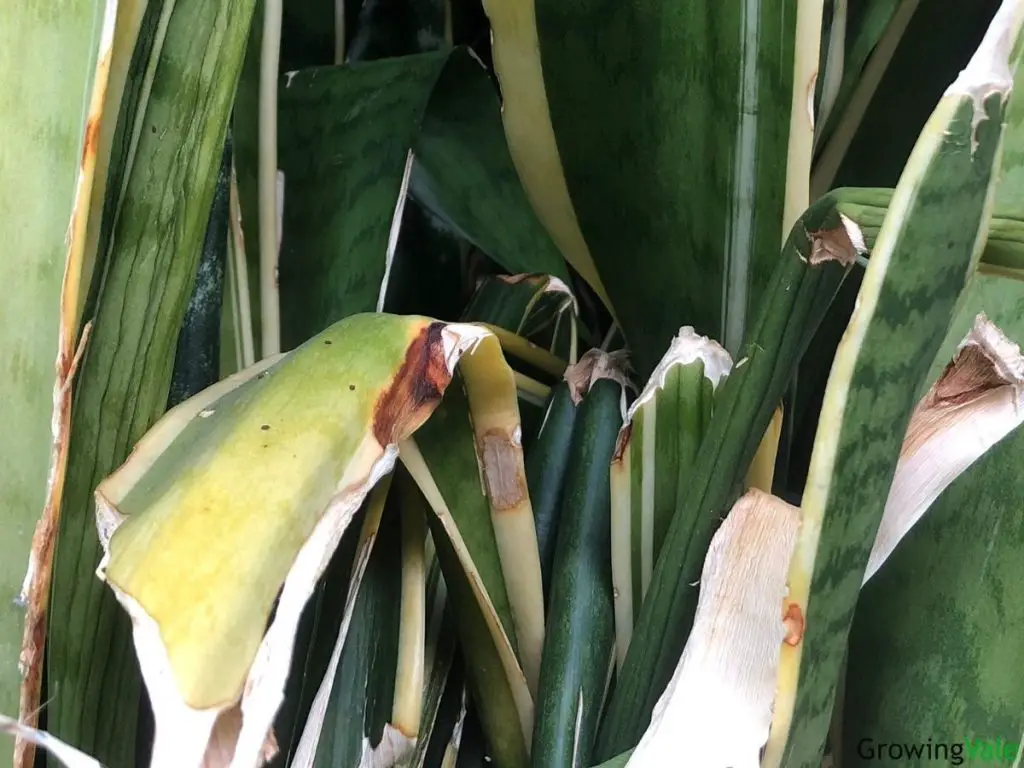Although Dracaena trifasciata is known as one of the hardiest houseplants, unfavorable conditions can cause its beautiful foliage to suffer. The tough leaves of a healthy snake plant stay upright, can be fully straight or twist slightly, and should be smooth along the surface.
Coloration should be consistent throughout the length of each leaf. Consult the list below for leaf abnormalities, causes, and potential solutions and learn how to take care of a snake plant.
Snake Plant Leaves Bending, Folding or Curling Inward
When the foliage is bent over slightly or folded forward, it is likely that your plant has been overwatered or that the soil in its pot is unable to dry out quickly enough. If the topmost layer of soil takes more than 24 hours to dry out, there may be standing water in your pot. Make sure that the pot has unblocked drain holes and is placed in a ventilated area.
If all the leaves fold slightly but remain firm, they may also be trying to access more sunlight. This can occur if the pot is situated in a dark corner of your home. You can try rotating the pot to encourage the leaves to straighten by bending in the opposite direction. You may also have to relocate the plant to a sunnier area.
In contrast, leaves that have curled inward are a sign of thirst or cold stress. Lack of water can cause the plant to allocate its moisture stores to newer leaves, causing older leaves to become shriveled and curl. If the curled portions feel brittle, check your soil’s moisture levels. Monitor the leaves for any lesions or spots as well, as common fungal infections could cause curling.
Snake Plant Leaves Drooping or Falling Over
Leaves that have fallen over completely are indicative of compromised root health. Rotten roots are unable to take up the nutrients required to support existing plant tissues and generate new ones. They also allow fungi, bacteria, and viruses to permeate into the plant and move upward into the leaf system. Drooping or flopping over often precedes fallen leaves.
Use your fingers to gauge the condition of your Sansevieria foliage. Drooping leaves that feel leathery, wrinkly, soggy, or mushy to the touch are full of necrotic or dying tissues. If some are falling over, have a close look at the base or crown of the plant. You may have to remove some of the soil to check if the leaf base has rotten over fully.
You will have to uproot the plant to remove all infected tissues. Start off by sorting through the roots and separating any that have become soggy or emit an unpleasant smell. A completely rotten root system unfortunately cannot be saved. You may have more luck saving cuttings of leaves that have not yet begun to droop or fall.

Snake Plant Leaves Turning Yellow
Some snake plant cultivars, such as ‘Golden Hahnii’ or ‘Gracilis’, naturally have yellowish foliage. If the leaves of your plant start off as green (or with the characteristic tricolor pattern of the species), and eventually turn more yellow over time, you can be sure that an underlying issue exists.
This issue can be caused by either overwatering or underwatering the plant. An irregular watering schedule may mean disaster for a mother-in-law’s tongue. When watering sessions are placed too close together and then timed too far apart, the roots can suffer and struggle to recover from potential pathogens. Aim to regulate your schedule, making sure the upper soil layers dry out completely in between watering sessions.
If you err too much on the side of underwatering your plant, the tips of the leaves will become yellow first and then eventually curl inward. You may opt to prune the yellow leaves as they are less able to fend off pests and pathogens.
Snake Plant Leaves Turning White
The green pigmentation of snake plant foliage is caused by the presence of chlorophyll in their cells. The amount of chlorophyll can vary depending on the plant’s sun exposure. If your Sansevieria plant is placed in a shaded area, you may notice its leaves become a more intense shade of green.
If it is placed on a windowsill that receives intense sunlight, chlorophyll production may be reduced and cause the leaves to become white. If this scenario is combined with a lack of water, the white leaves can become parched and can have brown spots or vertical splits along injured areas. Try to readjust the location of the pot relative to the window sill to encourage the production of more chlorophyll. This can, however, result in twisting leaves.
Snake Plant Leaves Turning Brown and Mushy
When your plant’s leaves are beginning to turn brown at the base and are soggy to the touch, the root system is definitely in big trouble. Keep in mind that the leaves of a healthy plant should be tough and shouldn’t buckle under light touch. Old leaves may have brown tips but should be removed from the main plant if they have browned over completely.
Compromised leaves will quickly attract an assortment of pests because they lose their resistance. Don’t delay uprooting the plant to check on the health of its roots. If some of the roots are still healthy (firm, yellow or white), your plant can still be saved. Also, prevent your leaves from becoming breeding grounds of disease by pruning those with brown or mushy parts.
Make sure to dispose of all rotting parts and sterilize any tools that come into contact with rot. Don’t skip this vital step as the fungus associated with root rot may be transmitted to your healthy snake plants.
Check our guide for more other snake plant diseases and problems.

